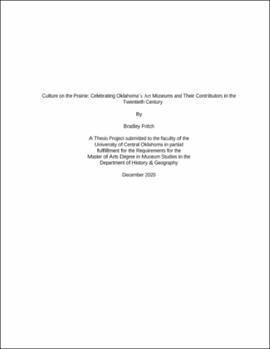| dc.description.abstract | The purpose of this project is to compile a brief history of Oklahoma art museums, while specifically honoring individual contributors that have made the existence of these museums possible. The emphasis on individual contributors is a result of my employment at the Oklahoma Hall of Fame at the Gaylord-Pickens Museum. With an institutional mission of "[preserving] Oklahoma's unique history while promoting pride in our great state...by telling Oklahoma's story through its people," it was necessary to highlight individuals that helped create Oklahoma's extensive museum network. In addition to the institutional constraints highlighted by the mission statement above, there were several factors that contributed to the selection process for inclusion in the project. The most restrictive of these factors was using Hall of Fame inductees whose portraits were already on hand at the Oklahoma Hall of Fame. When a portrait was not on hand, a loan agreements were met with a number of other institutions to borrow objects. Following the historical and institutional lens described above, this project follows the guidelines typically used in academic historical works. As such, this project is a combination of primary and secondary sources. The secondary sources are heavily utilized in the first chapter to provide a historiographical background of Oklahoma history. The state's history is important because it provides context to the state's art museum history. Additionally, secondary sources are utilized to help fill in gaps in the historical information. Throughout the rest of the work, primary sources including journals, letters, notes, newspapers or legislation are utilized to demonstrate one of ten individuals' contributions to an Oklahoma museum. Although this project focuses on the individual, this project argues that these persons are responsible for the art museum community that exists today. The third chapter employs the archival information presented in the second chapter to craft two different configurations of a museum exhibit. One configuration is an exhibit physically in the museum, while the other one is a virtual exhibit developed for the post-Covid world. Although there are several publications that focus their attention on the history of museums in general, there is very little work celebrating the history of museums with a commemorative exhibit. With that in mind, the aim of this project is to establish a model other states can follow to honor their state's own museum tradition. At the very least, the aim of this project is to establish a written discourse on the unique history of Oklahoma art museums so more work can be done on the unique history of the state's museums in general. | en_US |
